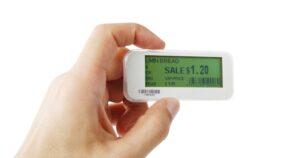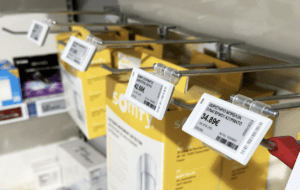Dans le monde en constante évolution de la technologie du commerce de détail, les étiquettes électroniques de rayon (ESL) ont changé la donne, révolutionnant la façon dont les magasins gèrent leurs stocks et leurs prix. Le parcours des étiquettes électroniques, depuis leur conception initiale jusqu’aux outils avancés et efficaces qu’elles sont aujourd’hui, reflète la quête permanente d’efficacité opérationnelle et d’amélioration de l’expérience d’achat. Examinons de plus près l’histoire des étiquettes électroniques de rayonnage et l’évolution de la technologie au fil des ans.
Naissance de la technologie ESL

Le concept des étiquettes électroniques de rayon remonte au début des années 1990, lorsque les détaillants ont commencé à chercher des moyens d’améliorer la précision des prix et de réduire la charge de travail associée à la mise à jour manuelle des étiquettes de prix en papier (Source : Retail Technology Quarterly, 1993). Le système traditionnel de changement manuel des étiquettes de prix était gourmand en main-d’œuvre, source d’erreurs et inefficace, en particulier pour les grands magasins qui proposaient des milliers de produits. L’idée d’une étiquette numérique pouvant être mise à jour à distance était une solution attrayante, d’autant plus que le secteur de la vente au détail devenait plus compétitif et exigeait une plus grande précision dans la fixation des prix.
Les premiers systèmes ESL étaient rudimentaires par rapport à ce que nous voyons aujourd’hui (Source : TechHistory Magazine, 1996). Ils utilisaient de simples écrans à cristaux liquides (LCD) et communiquaient par l’intermédiaire de la technologie infrarouge, ce qui nécessitait une visibilité directe entre les émetteurs et les étiquettes. Ces premiers modèles, bien que révolutionnaires pour l’époque, étaient limités en termes de fonctionnalité, de portée et d’évolutivité. Néanmoins, ils donnaient un aperçu de ce que l’avenir pouvait réserver : un moyen pour les détaillants de gérer leurs prix de manière transparente tout en réduisant les erreurs humaines et les coûts.
L’essor des écrans à radiofréquence et à papier électronique
Dans les années 2000, la technologie ESL a commencé à mûrir (Source : Retail Innovations Report, 2001). L’introduction de la communication par radiofréquence (RF) a permis une plus grande flexibilité, car la RF ne nécessite pas de visibilité directe pour communiquer avec les étiquettes. Cette innovation a permis aux détaillants de déployer des LEF dans l’ensemble de leurs magasins sans se soucier des signaux obstrués ou des limites imposées par la technologie infrarouge. Le passage aux ESL basés sur la RF a considérablement amélioré l’efficacité et la fiabilité de ces systèmes, ce qui en fait une option plus attrayante pour les détaillants de toutes tailles.
À peu près à la même époque, un autre progrès majeur a été l’adoption des écrans à papier électronique, dont E Ink est le principal fournisseur (Source : E Ink Corporation, 2004). Contrairement aux écrans LCD traditionnels, les écrans e-paper offrent une meilleure lisibilité, en particulier dans des conditions de forte luminosité, et nécessitent une alimentation minimale pour maintenir l’affichage – ils ne consomment de l’énergie que lorsque le prix ou l’information est modifié. La durée de vie des piles s’en est trouvée considérablement améliorée, de nombreuses étiquettes pouvant durer plusieurs années sans avoir besoin d’être remplacées. La combinaison de la technologie RF et des affichages sur papier électronique a marqué un tournant important, rendant les étiquettes plus pratiques, plus conviviales et plus rentables.
Adoption généralisée et intégration dans les systèmes de vente au détail

Dans les années 2010, les ESL ont été largement acceptés par les grandes chaînes de magasins en Europe, en Asie et finalement en Amérique du Nord (Source : Global Retail Adoption Survey, 2015). Au Canada, les premiers adoptants comprenaient de grandes chaînes d’épicerie comme Loblaw et Metro, tandis qu’aux États-Unis, des détaillants comme Kroger et Walmart ont été parmi les premiers à mettre en œuvre la technologie ESL pour améliorer la précision des prix et renforcer l’efficacité opérationnelle (Source : North American Retail Technology Review, 2018). Les pays qui ont été les premiers à adopter les étiquettes électroniques en rayon sont la France, l’Allemagne et le Japon, motivés par la nécessité d’améliorer l’efficacité opérationnelle, la précision des prix et la réduction des coûts de main-d’œuvre (Source : European Retail Study, 2010). Les pays européens, en particulier la France et l’Allemagne, ont été les premiers à adopter les étiquettes électroniques en raison de l’importance qu’ils accordent à l’innovation dans le secteur de la vente au détail et de leur volonté d’améliorer l’expérience d’achat en magasin. Au Japon, l’adoption a été motivée par la nécessité de rationaliser les opérations et de faire face à la pénurie de main-d’œuvre, ce qui a incité les détaillants à investir dans des technologies d’automatisation telles que les ESL.
Cette adoption généralisée est en grande partie due à l’évolution des logiciels et des capacités d’intégration des systèmes. Les ASP ont commencé à être intégrés à des systèmes plus larges de gestion de la vente au détail, ce qui a permis des mises à jour en temps réel dans l’ensemble des réseaux de magasins. Les détaillants pouvaient désormais modifier les prix presque instantanément, réagir aux prix des concurrents et ajuster les promotions sans intervention manuelle.
Cette intégration correspondait également à l’essor de la vente au détail omnicanale. Alors que les consommateurs commencent à faire leurs achats à la fois en ligne et en magasin, les ESL offrent aux détaillants un moyen simple de garantir la cohérence des prix sur tous les canaux. La possibilité d’ajuster dynamiquement les prix en fonction des promotions en ligne ou des conditions du marché local a aidé les détaillants à rester compétitifs et à offrir une expérience transparente aux acheteurs.
Les ALS modernes et les solutions de vente au détail intelligentes
Aujourd’hui, la technologie du site ESL est plus avancée et plus sophistiquée que jamais. Les ASP modernes ne se contentent pas d’afficher les prix, mais fournissent également un large éventail d’informations, telles que la disponibilité des stocks, les spécifications des produits et les messages promotionnels. Les dernières ESL utilisent des écrans couleur en papier électronique, qui améliorent la visibilité des produits et offrent de meilleures possibilités de promotion. Ces étiquettes peuvent être personnalisées pour refléter les couleurs de la marque, les logos et d’autres éléments visuels, ce qui contribue à l’esthétique générale des rayons des magasins.
L’évolution des protocoles de communication s’est également poursuivie, avec l’introduction du Bluetooth et de la connectivité IoT (Internet des objets). Cela permet des interactions plus complexes entre les ALS, l’infrastructure du magasin et même les consommateurs. Par exemple, certains détaillants utilisent les ALS pour interagir avec les smartphones des clients, en proposant des réductions personnalisées ou des informations sur les produits lorsqu’un client se trouve à proximité d’un produit particulier. L’expérience client s’en trouve améliorée, transformant l’humble étiquette de prix en un puissant outil de marketing.
Une autre tendance clé de l’évolution de ESL est la durabilité. Les consommateurs et les entreprises étant de plus en plus soucieux de l’environnement, les étiquettes électroniques constituent une alternative intéressante aux étiquettes traditionnelles en papier, réduisant les déchets de papier et minimisant l’empreinte carbone associée aux changements fréquents d’étiquettes. Des progrès ont également été réalisés dans le domaine de l’alimentation solaire, ce qui renforce encore la durabilité de ces dispositifs.
L’avenir de l’anglais langue seconde
À l’avenir, la technologie ESL continuera probablement d’évoluer parallèlement aux progrès de l’intelligence artificielle et du big data. Imaginez un site ESL capable d’ajuster dynamiquement les prix en fonction de l’analyse des données en temps réel sur le comportement des clients, les conditions météorologiques ou même les prix pratiqués par les concurrents, le tout sans intervention humaine. À mesure que l’IA s’intègre dans les opérations de vente au détail, les ESL pourraient jouer un rôle clé dans l’automatisation des stratégies de tarification et la garantie d’un placement optimal des produits.
En outre, l’évolution constante vers la vente au détail intelligente et l’automatisation ne fera qu’accroître la pertinence des ALS. À mesure que les magasins adopteront les caisses sans caissier et la gestion automatisée des stocks, les ASP serviront de lien crucial entre les domaines physique et numérique, fournissant aux acheteurs des informations précises et actualisées tout en permettant des interactions transparentes avec d’autres systèmes intelligents dans le magasin.
Conclusion
L’évolution des étiquettes électroniques de rayonnage reflète la transformation plus large de l’industrie du commerce de détail vers plus d’efficacité, de précision et de centrage sur le client. Depuis leurs humbles débuts en tant que simples écrans LCD avec une connectivité limitée jusqu’aux dispositifs couleur sophistiqués et compatibles avec l’IdO que nous voyons aujourd’hui, les ESL ont parcouru un long chemin. À mesure que la technologie continue de progresser, les étiquettes électroniques pour rayonnages joueront sans aucun doute un rôle central dans le façonnement de l’avenir du commerce de détail, en le rendant plus intelligent, plus réactif et plus en phase avec les besoins des consommateurs et des entreprises.
Prochaines étapes
Pour en savoir plus sur nos solutions d’étiquetage électronique et comment elles peuvent bénéficier à votre entreprise, contactez-nous pour une consultation. Nous serons heureux de discuter de la manière dont nous pouvons adapter notre système à vos besoins spécifiques, à vos objectifs et à votre budget.




